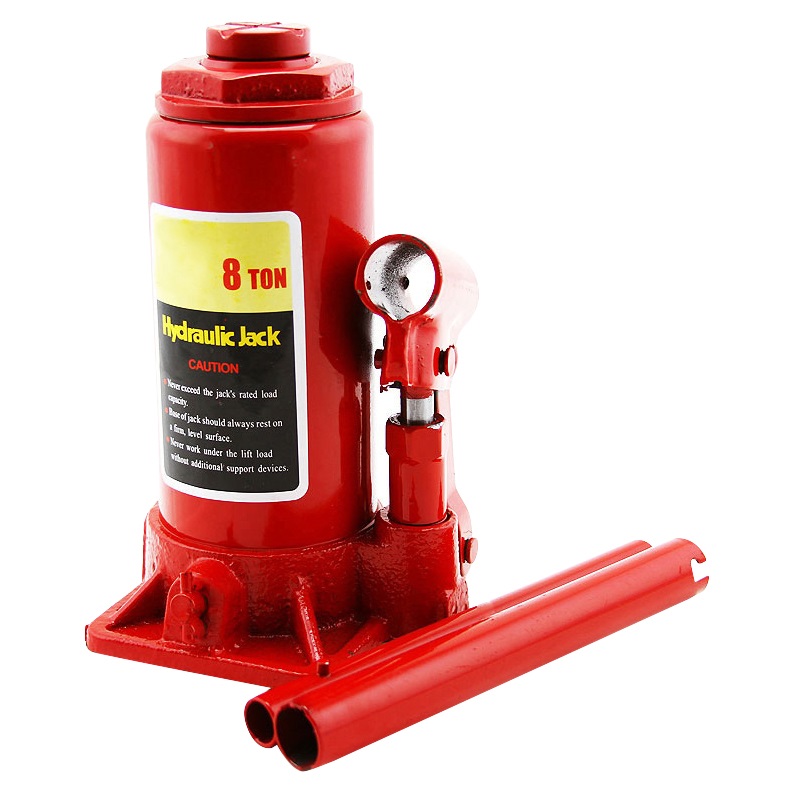
Working Principle, Troubleshooting and Maintenance Method of Hydraulic Jack
Keyword:Hydraulic Jack Time:2019-11-7 19:03:46
The working principle of hydraulic jack is to realize the working cycle through the hydraulic transmission mechanism. From the following figure, we will give you an analysis of the working principle of hydraulic jack, which is from the main cylinder 6, through hydraulic pump F1 to deliver hydraulic oil through high pressure hose 7 to the hydraulic cylinder 6, to see the pressure of the pump and the height of the lifting (and the working lifting object of the cylinder), hydraulic Jack in the case of pressure to flat ground. When working on the surface, the lifting weight on the top needs to be on the same parallel plane, so as to maintain the stability of the hydraulic lifting and the slowness of the speed rise and fall.
By looking at the working principle of hydraulic jack, we can easily see that hydraulic jack is a new multi-purpose tool. It is composed of oil pump and jack. It can carry out lifting, jacking, straightening, bending, pressure test and other work. It has the characteristics of compact structure, simple operation, convenient use, safety and quick loading and unloading. For factories and oilfields, hydraulic jack is a new type of multi-purpose tool. Ships, wharfs, warehouses, railway buildings and scientific research are all applicable.
Now let's know how to use the electric hydraulic jack.
1. Cooperate the joint of the high-pressure rubber hose on the oil pump with the joint of the jack, and then tighten the discharging screw on the jack of the oil pump separately. Even if the screw is used, the screw will be loosened after the work, so that it can be restored to its original state.
2. If the pump needs to refuel, the screw at the end of the pump can be removed to refuel, and the oil should be kept clean.
Cautions for electric hydraulic jack:
1. If the pump has suction phenomenon, it should be supplemented with oil.
2. If there is a long time unloading, it is necessary to install pressure retaining valve, and then the drain screw on the turpentine pump. Pull out the joints on the high-pressure pipe and keep the rest of them still, so as to achieve the goal of not falling down.
3. Connect the high-pressure pipe on the basis of no pressure.
The reason why the piston does not rise may be that there is no oil supply in the pumping station or the sealing of the upper and lower chambers of the cylinder or the left and right chambers of the hydraulic control one-way valve is damaged. First, repair the oil pump. Then replace the O-ring and the retaining ring.
Pressure rises but piston does not.
The reason is that the pipeline is blocked by garbage or damage in the quick joint or hose. The motor should be closed immediately to check the clean joint or replacement parts, and the hose and other channels should be blown clean with compressed air.
Lifting weight drop
The first reason is that the sealing gasket of the hydraulic control one-way valve is damaged. The second is the wear and tear of sealing elements, resulting in leakage.
Seal gaskets and sealing elements should be replaced.
Piston Lifting Can't Drop
The first reason is that the piston is deformed due to overload or eccentric load, and the second reason is that the pipeline is blocked. Third, the one-way valve stem did not push the steel ball away. Pistons can be repaired or replaced. Close the motor immediately to check the clean joint or replacement parts, and clean the hose with compressed air. Finally, change the stem.


- No information
-
1. Design objective of electronic crane scale network management. (1) Adopt advanced distributed data processing techno…
-
Electronic crane scale bearing platform installation to focus Electronic crane scale can be installed generally on the li…


